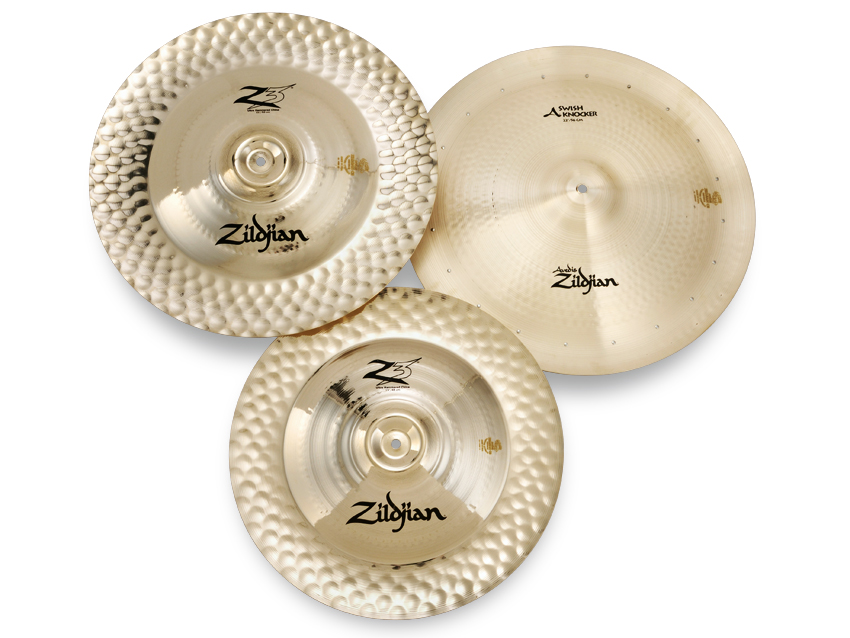MusicRadar Verdict
All three cymbals are distinctive in look, sound and application. They have a kind of Marmite appeal - you'll probably either love them or hate them.
Pros
- +
Versatile. High build quality.
Cons
- -
Fairly niche applications.
MusicRadar's got your back
Curiously named, the 22-inch Swish Knocker is based on the particular cymbal Mel Lewis played weekly at the Village Vanguard club in New York with his celebrated jazz orchestra over a quarter-century up till 1990.
The other two Chinas are new additions to the noisy Z3 brigade - cymbals aimed more towards tattooed rockers and metal heads. Z3, introduced in 2009, is the third generation of Zs, designed with increased flex so as to be more easily playable.
Build
Zildjian has already offered a 22-inch Swish Knocker for several years, but it was evidently not exactly the same as the inspirational Mel Lewis prototype. Mel's actual (Turkish 'K') cymbal had been passed on to his successor, John Riley, and Zildjian Director of Research and Design, Paul Francis, managed to borrow it in order to copy it precisely.
"I took some measurements from Mel's Knocker," explains Paul, "and built some tooling where we would get the same curvature every time." Consequently this new model has a slightly higher profile and a less curvaceous cup.
It also features 20 rivets and a traditional 'A' Zildjian satin finish. The two other Ultra-hammered Chinas are additions to the already extensive Z3 line of B20 bronze professional cymbals.
Although aimed at our brasher brethren, these two Chinas are thin, yet designed specifically to project and cut. This is achieved via the extensive hammering and unique 'volcano' profile bells.
Paul Francis explains that "the 19-inch and 21-inch Z3 Ultra-hammered Chinas were an experiment with new cup designs. Zildjian was working on four new cup designs and decided to see which one worked well in a China cymbal".
The cup Zildjian settled on is called the Volcano since it has an inner dip rather than rising to a normal rounded dome. Compared with the existing 18-inch and 20-inch Z3 Chinas, these Ultra Chinas have noticeably wider flanged rims which are heavily hammered, while in the body of the cymbal there are four hammer rows which serve to interrupt the curvature and accentuate the trashiness.
With the brilliant finish and the dashing logo this all adds up to a striking look.
Hands On
The Swish Knocker is certainly an atypical cymbal, one which will get you noticed. Played as a straight ride with stick tip near the midpoint of the body it has a bell-like chiming tone over the darker, mysterious body, with the chattering rivets following on.
The rivets add sizzle but die quickly once you stop playing. Crash the upturned brim and you get a pretty harsh trash-can sound. The bell is flattened on the top and if you strike here it is surprisingly deep and nutty, but glance just to the side and it is high-pitched and piercing. A double bell sound, then.
As for how to use it, it's instructive to seek out Mel's understated, musical playing on YouTube, eg: with the Thad Jones-Mel Lewis big band where he positioned his Knocker on the extreme right of his kit.
Paul Francis remarks: "Armand Zildjian told me that this cymbal is not a China or special effects cymbal. It is a ride cymbal for use in the shout chorus where all the brass is playing.
"It is called a Swish Knocker because it has the shape of a swish but the 'knocker' comes from knocking time on it."
Turning to the Ultra Hammered Chinas, the problem with a lot of HM cymbals is that in making them heavy for power and maximum penetration they can sound, as Zildjian helpfully puts it, "like hitting manhole covers".
The Z3s have therefore been made more flexible which eases the playing. And the Ultra Chinas are actually quite thin, increasing the trashiness and deepening the tone. In fact, Zildjian says, the sound is trashier than you get with the 18-inch and 20-inch normal Z3 Chinas.
Because of the flat centre of the cup you can mount the cymbals either way up with equal ease resulting in only marginally different sounds. The shouldered stick on the broad lip obviously makes the most din - pretty fearsome: a fat and high-pitched crash, a big thundery explosion which is immediate in its effect, dropping off quickly.
But then - since the cymbal is heavily hammered and thin - there is plenty of after-sustain. A cloudy, trashy afterglow. Riding with the stick tip you get a high pitched, edgy tang with a bright ringing tone and deeper trashy undertone.
So both cymbals are versatile, depending on where/how you attack them. The cup sound however is virtually non-existent since there is no normal rounded bell.
All three cymbals are distinctive in look, sound and application. They have a kind of Marmite appeal - you'll probably either love them or hate them. Looking at Mel Lewis's YouTube clips we could see how the Swish Knocker adds terrific colour when used inventively.
And the same applies to the Z3s - they may not appear to be for the more sensitive palette, but they are far from crude.
“We were arguing a lot and we were miserable”: How Green Day exceeded expectations with their most ambitious song
"There’s plenty for us guitarists to learn – and ‘less is more’ is the overriding lesson": how to play like George Harrison on The Beatles' Abbey Road
“They didn’t like Prince’s bikini underwear”: Prince’s support sets for the The Rolling Stones in 1981 are remembered as disastrous, but guitarist Dez Dickerson says that the the crowd reaction wasn’t as bad as people think










